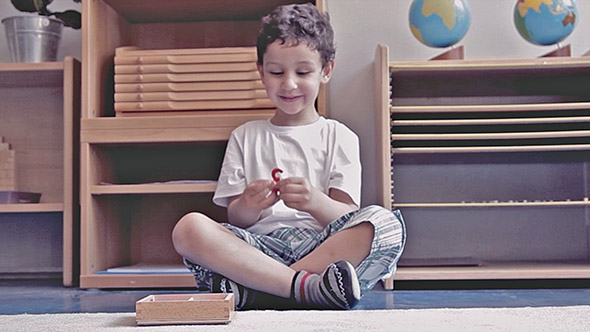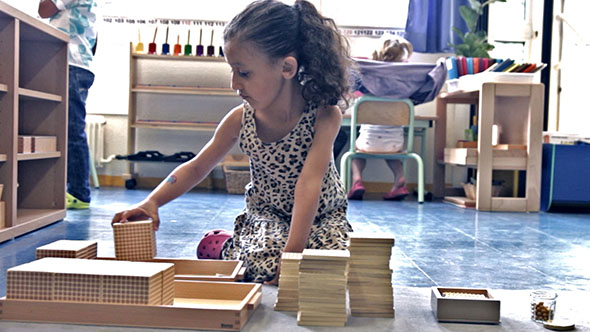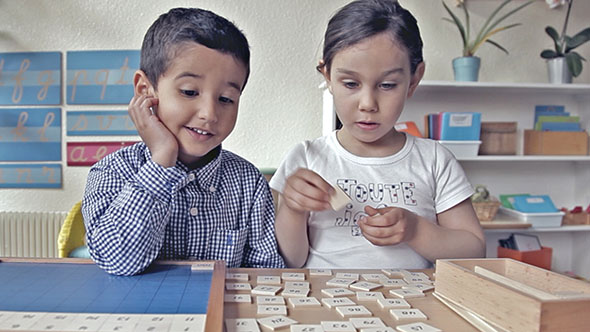Mathematics
As intellectually engaging as the activities presented below are, they nevertheless remain a pedagogical crutch whose effectiveness depends on the adult’s capacity to create a conducive interpersonal environment. It’s above all the warm, collaborative, cheerful and trusting bond between the children that will enable them to thrive and fully deploy their questing intelligence. It’s this human dimension that really makes the difference.

To enable the children to hone their innate sense of number - through counting, matching symbols/quantities and handling “real” quantities - we once again used the materials designed by Dr Séguin and Dr Maria Montessori but made them our own to meet the needs of each child. We find these materials appealing for two reasons. Firstly, they make clear the concepts of “quantity”, “decimal system” (base 10) and the “numbering of position”, which are essential to understanding the mathematical code. Secondly, they offer an appropriate step-by-step approach: each activity involves acquiring just one item of knowledge, which avoids double-task situations and facilitates learning. We have supplemented these activities with a simple but essential item to provide the children with reference points: a number wall chart which stretches right around the classroom.

Please don’t regard the activities presented below as an end-goal for you. They are intended to serve as a point of departure, a source of inspiration and a platform for experimentation. Make them your own and complement them with any other activity that you consider appropriate.
Quantities & Symbols, from 1 to 10
We begin by presenting the number wall chart. This activity satisfies the children’s desire to count ever higher while enabling them to assimilate the concept of linearity (each number is followed by a number composed of one additional unit). When the children can recite the beginning of the series and count up to 3 with the help of the wall chart, they then assimilate the quantities one to ten with the number rods.
In parallel, we present to them the visual symbols coding for the quantities from “one” to “nine” using the sandpaper numbers. The children name the number and trace it out at the same time. This multi-sensory approach facilitates the learning of numbers: our brain is better at retaining a piece of information when that information arrives simultaneously via various senses - visual, tactile, auditory.¹ Research indicates that this type of approach is highly beneficial for every child and that it is particularly helpful for those who present specific learning difficulties.² The children then match symbols and quantities by placing the numbers on the number rods.
The following step is to ask the children to construct the quantities up to 10 themselves using the spindles and the counters. The level of difficulty increases significantly: numbering quantities whose units are separate is much more difficult than numbering quantities whose units are attached together. This requires the children to draw on their working memory and their inhibitory control, which are still fragile: they have to retain the number of units they are holding and count additional units until they reach the desired quantity, while making sure the units don’t roll around on the table!
At this stage, the children have already honed very effectively their natural capacity to perceive quantities: by the time they are barely four years old, they are capable of assembling a collection comprising between one and ten objects, rapidly perceiving the difference between these various quantities and matching them with a symbol.
Decimal system
As soon as the children can count up to 10 and recognise the numbers from 1 to 9, we present to them the code for reading and writing the quantities. Although these activities may seem complex because they involve the base 10 and the numbering of position, the children love them and don’t need to know how to count above 10 in order to do them. Very early on, they can thereby satisfy their burning desire to handle big quantities and big symbols. Though we mainly chose to ask the children to perform additions, multiplications and divisions with the beads, it’s entirely possible to present subtraction to them too. You’ll find the procedure in the pop-up in the Addition & Multiplication video.
When the children are comfortable with handing the beads, they can take a further step towards abstraction by doing sums using the stamps: this time, the categories (units, tens, hundreds, thousands) are represented by small tiles of the same size, unlike the tiles used with the beads whose size increases as the value increases.
At this stage, most of the 5-year-olds in the class were capable of doing - and understanding the concept of - addition, subtraction, multiplication and division by numbers with several digits. They helped the youngest ones by explaining how they went about the task. Some even started calculating these large sums mentally: when two children were having fun doing an addition together and were saying out loud to a third classmate “4000 + 3200”, it was not unknown for a child sitting a bit further off and colouring a mandala, for example, to unwittingly ‘spoil’ the work of their classmates by declaring out loud ‘7200’!
Quantities & Symbols, from 10 to 1000
In parallel, the children continued at their own pace to hone their perception of quantities up to 100 and then up to 1000 and at the same learning the corresponding symbols.
Practising addition & multiplication
Always in parallel with the decimal system activities, but only when the children have grasped the function of each sum - putting together (+), taking away (-), dividing into equal parts (:), and putting together the same quantities (x) - we can suggest they add and multiply small quantities. This helps them to hone their innate sense of number and, through repetition, to memorise certain combinations.
And in the third year of nursery school?
You’ll have noticed that we presented these activities when the children were between 3 and 4½, so during the first and second year of nursery school. These are the two years when the children show great interest in developing their sense of number. From the age of 3, they want to “count a long way” and name the numbers. So this is the age at which we started mathematics. At the age of 4½, most of the children had already practised the activities presented here. If some of them wanted to take things further, we proposed new activities to them such as the abacus. But that was extremely rare: over the course of three years, this situation arose only once. For the majority of the children in their third year of nursery school, after practising all these activities their need to hone their sense of number had been catered to and satisfied. They then expressed a need for a rest from numerical cognition. They developed a distinct preference for reading out books together, playing freely with their friends outside, and deploying their newly developed executive skills by carrying out big projects (like building huts) or climbing trees. For architectural, environmental and institutional reasons, unfortunately we weren’t able to cater satisfactorily to all these needs, but we encourage you to find a means to do so. And there’s no need for concern - although they leave mathematics to one side for a while, the children do not lose what they have learnt. They continue to be immersed in an environment where mathematics is very present and are willing to help out the children who are still doing these activities.
The level of numerical skills that the children in Gennevilliers acquired by no means implies that you should expect every child to be able to do four-digit divisions at the age of four. Each child has different capacities and interests, and we shouldn’t expect that they all develop the same skill levels in every domain at the same time. What our experiment does however highlight - and this is the core of our message - is that in all likelihood we have seriously underestimated until now the amazing capacities of humans in their first years of life, in particular their intuitive mathematical capabilities, and that, if they fail at school, it’s perhaps not because we are getting them to do tasks that are too difficult for them, but probably because those tasks do not do justice to their great capabilities. The children wear themselves out doing tasks that don’t interest them and are not worthy of their great intelligence.
Not all children will get as far so early on, and there’s nothing wrong with that;
but all of them have much higher aspirations than
catered to by the activities we usually propose to them.

1. Gentaz E., Colé, P., Bara, F. Evaluation d’entraînements multisensoriels de préparation à la lecture pour les enfants en grande section de maternelle : une étude sur la contribution du système haptique manuel, L’année psychologique, 2003 - 4: 561-84; Bara F., Gentaz E., Colé P., Sprenger-Charolles, L. The visuo-haptic and haptic exploration of letters increases the kindergarten-children’s reading acquisition, Cognitive Development, 2004 - 19: 433-49 ; Bara, F., Gentaz, E., Colé, P., Sprenger-Charolles, L. Les effets des entraînements phonologiques et multisensoriels destinés à favoriser l’apprentissage de la lecture chez les jeunes enfants, Enfance (PUF), 2004; Gentaz, E., Collignon, H. Apprendre à lire avec les doigts, Medecine et Enfance, 2004.
2. www.dyslexia-international.org
























